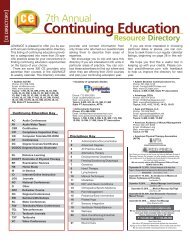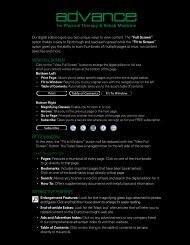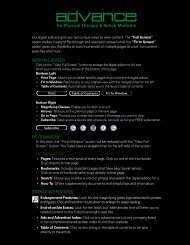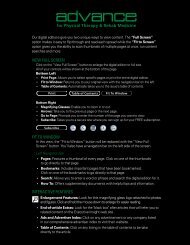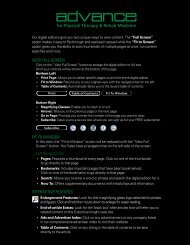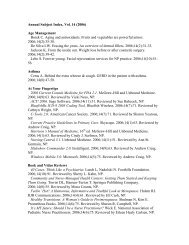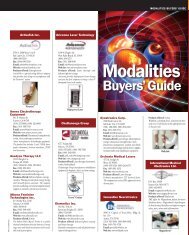Download - ADVANCE for Physical Therapy & Rehab Medicine
Download - ADVANCE for Physical Therapy & Rehab Medicine
Download - ADVANCE for Physical Therapy & Rehab Medicine
Create successful ePaper yourself
Turn your PDF publications into a flip-book with our unique Google optimized e-Paper software.
Response Time<br />
Using a SCENAR device<br />
in a contemporary PT<br />
practice By shmuel Tatz, PT, PhD<br />
Aphysician, an orthopedic surgeon<br />
and a physical therapist all fell into<br />
a Rip Van Winkle sleep that lasted<br />
20 years. The physician woke to<br />
find everything changed when he began seeing<br />
patients again. The medications he wished<br />
to prescribe no longer existed or were pulled<br />
from the market by the FDA. For the surgeon,<br />
the operating room had been trans<strong>for</strong>med;<br />
the instruments he had once used were now<br />
in a museum.<br />
But <strong>for</strong> the physical therapist, nothing<br />
much had changed. He found he could use<br />
the same techniques <strong>for</strong> mobilization and the<br />
same modalities such as ultrasound or electrical<br />
stimulation. In addition, the physical<br />
therapist found that he had lost his massage<br />
patients to massage therapists, stretching<br />
techniques to athletic trainers, manipulation<br />
techniques to chiropractors and hand therapy<br />
to hand therapists.<br />
Indeed, the contemporary practice of<br />
physical therapy has had little in the way of<br />
modalities added to the techniques of handson<br />
manipulation. <strong>Physical</strong> therapists are<br />
not always aware of new products that can<br />
enhance our ability to help patients.<br />
Gaining Approval<br />
I discovered the laser in the 1980s. One of my<br />
patients told me of a good experience she had<br />
had with another physical therapist who used<br />
the laser in his practice. It took another 20 years<br />
<strong>for</strong> the FDA to approve its use. In the 1990s<br />
another patient told me about a scanner that<br />
another therapist had used in his work with<br />
her which was of great benefit. It took another<br />
20 years <strong>for</strong> the FDA to approve the scanner.<br />
PRODUCTS AT WORK<br />
sCeNAr (self Controlled electro Neuro Adaptive<br />
regulator) is simple to use and causes<br />
little to no discom<strong>for</strong>t <strong>for</strong> patients.<br />
There are many articles written about the scanner<br />
known as SCENAR, or Self Controlled<br />
Electro Neuro Adaptive Regulator, and how it<br />
works. In one of them, Overview of Scenar therapy<br />
and its Application to Physiotherapy Practice,<br />
the author, J.C. Lyons, B.Sc (Aust) UNSW, Dip<br />
sCeNAr continued on page 37<br />
SCENAR MEDICAL TECHNOLOGY<br />
“The Pain solution <strong>for</strong><br />
your patients and<br />
your practice”<br />
www.TOMATEX.com<br />
Scenar@tomatex.com<br />
989-272-3627<br />
USA FDA K092117, CE 0120,<br />
Health Canada DL:86149<br />
<strong>ADVANCE</strong> <strong>for</strong> <strong>Physical</strong> <strong>Therapy</strong> & <strong>Rehab</strong> <strong>Medicine</strong><br />
27



